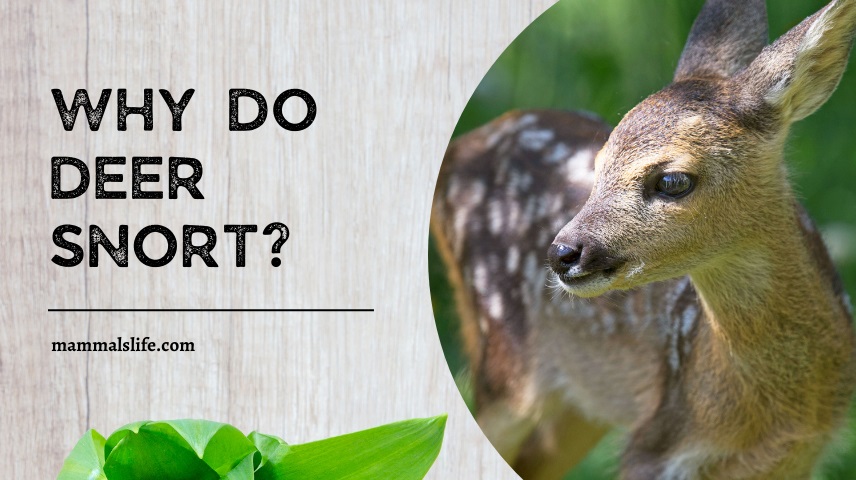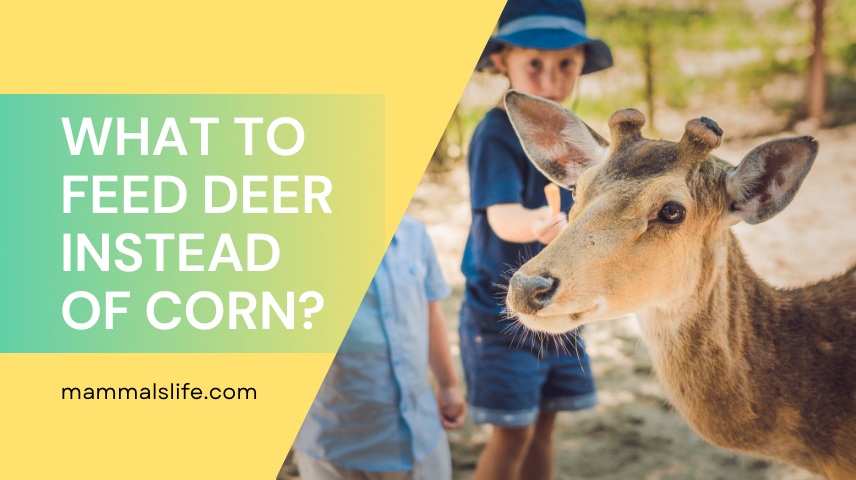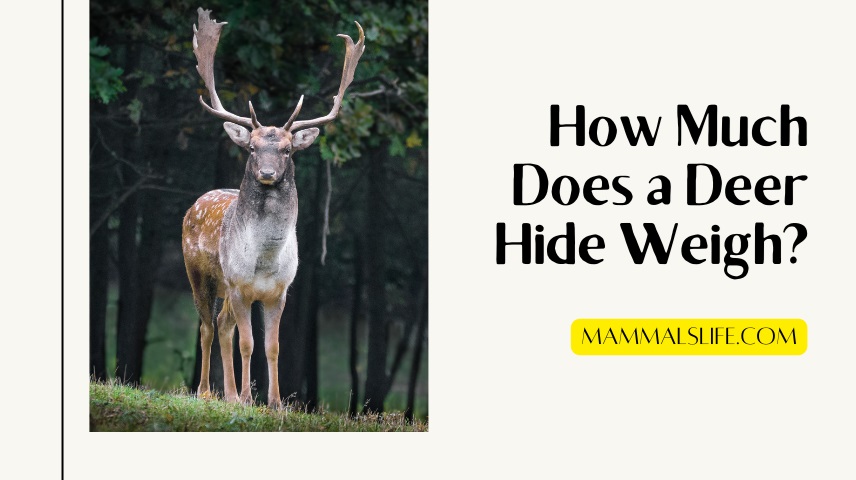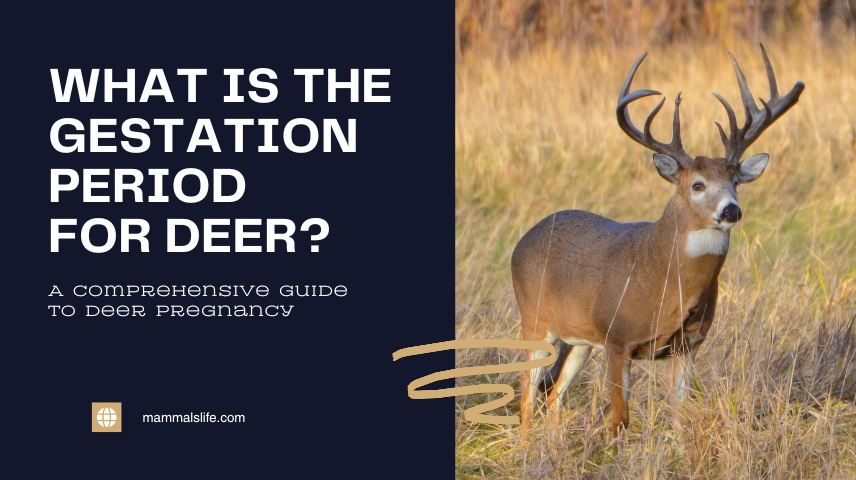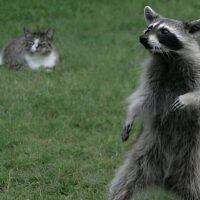Last Updated on February 22, 2025 by Mammals Life
Deer snort to alert others of danger and to communicate distress. This behavior is rooted in survival instincts.
Deer snorting serves as a crucial communication tool in their natural habitat. These snorts, often sharp and loud, signal potential threats to other deer nearby. The snorting sound can startle predators, giving deer a chance to flee. By understanding this behavior, we can appreciate the intricate survival mechanisms deer have developed.
This instinctive reaction helps maintain the safety and cohesion of deer herds. Observing deer snorting can provide valuable insights into their behavior and environmental interactions. It highlights the importance of these vocalizations in their daily lives and survival strategies.
Deer Communication Methods
Deer are fascinating creatures with diverse communication methods. They use vocalizations, body language, and other signals to convey messages. Understanding these methods helps us learn more about their behavior. Let’s explore two primary ways deer communicate: vocalizations and body language.
Vocalizations
Deer vocalizations are varied and serve multiple purposes. They grunt, bleat, and snort. Each sound has a different meaning.
- Grunts: Indicate low-level threats or social interactions.
- Bleats: Used by fawns to call their mothers. Adult deer also bleat in social settings.
- Snorts: Signal alarm or danger to other deer.
Deer snorts are particularly interesting. They are loud and sharp. This sound warns other deer of potential threats. It also startles predators, giving deer a chance to flee.
Body Language
Body language plays a crucial role in deer communication. Deer uses various gestures and postures.
| Gesture | Meaning |
|---|---|
| Tail Flagging | Signals danger. The tail is raised and flicked. |
| Ear Position | Indicates mood and awareness. Ears forward show alertness. |
| Foot Stomping | Warns other deer. It is a sign of agitation. |
These body language signals are vital for deer survival. They help deer maintain social bonds and avoid predators. Understanding these signals gives us insight into deer behavior.
Read More – When Do Deer Have Babies? A Guide to Deer Reproduction And Birth
The Mechanics Of Snorting
Understanding the mechanics behind deer snorting can be fascinating. This behavior is not just random. It serves specific purposes for these animals. Let’s dive into how snorting works and its frequency and duration.
How Snorting Works
Deer snort by expelling air through their nostrils. This creates a loud sound. The process involves their respiratory system. They forcefully push air from their lungs. This action produces a distinctive noise.
The snorting sound varies in intensity. It depends on the deer’s state of alertness. A more forceful snort often means higher stress or danger.
Frequency And Duration
The frequency of deer snorting can vary. It depends on the situation. A deer may snort once or multiple times. If a threat is near, snorting is more frequent.
The duration of each snort is usually brief. It lasts less than a second. The short duration makes it easy for deer to repeat the action quickly.
Below is a table summarizing the key points about snorting frequency and duration:
| Aspect | Details |
|---|---|
| Frequency | Varies based on threat level |
| Duration | Less than a second |
| Intensity | Higher with more stress |
Understanding these aspects helps explain why deer snort. It is a crucial part of their behavior. This knowledge can aid in better wildlife observation.
Snorting As A Defense Mechanism
Deer are fascinating creatures with unique behaviors. One such behavior is snorting. This action is not random; it serves as a crucial defense mechanism. The snort of a deer can alert the herd to danger and deter predators. Let’s dive deeper into these intriguing aspects of deer snorting behavior.
Alerting The Herd
When a deer senses danger, it snorts loudly. This sound acts as an alert for other deer nearby. The snort warns the herd of potential threats. Deer have a strong social structure. Their survival depends on communication and awareness. A single snort can save lives by triggering a swift response.
Deterring Predators
Deer snort to scare off predators. The snort is loud and sudden. It can startle animals like wolves or coyotes. This unexpected noise can make predators rethink their attack. The snort acts as a deterrent. It helps deer gain a few precious moments to escape. This simple act is a powerful tool for survival.
Environmental Triggers
Deer snort for various reasons, often triggered by their environment. These environmental triggers can range from the presence of predators to changes in their surroundings. Understanding these triggers helps us appreciate why deer snort and what they communicate through this behavior.
Presence Of Predators
One primary cause of deer snorting is the presence of predators. Deer have keen senses and can detect predators from afar. When they sense a threat, they snort to alert other deer. This snort serves as a warning signal, enabling the group to react quickly.
Predators that can trigger this response include:
- Wolves
- Bears
- Humans
Each predator type can elicit a different level of response. Deer may also snort multiple times if the threat is severe. This behavior increases their chances of survival.
Changes In Surroundings
Deer are highly attuned to their surroundings. They notice even minor changes in their environment. These changes can include new objects, unusual sounds, or sudden movements. When deer encounter such changes, they may snort to express curiosity or caution.
Common changes that can trigger snorts are:
- New structures or objects
- Unfamiliar animal sounds
- Sudden movements in the bushes
Deer snort in response to these changes to communicate with their herd. This helps them stay aware and safe in a constantly changing environment.
Read More – How Far Away Can Deer Smell Corn? Tips for Using Corn As an Effective Deer Attractant
Comparative Behavior In Other Animals
Deer snort as a defense mechanism to alert others of potential danger. This behavior combines instinct and communication, ensuring her safety.
Deer snorting is a fascinating behavior. Understanding it involves looking at similar behaviors in other animals. Let’s explore how other mammals communicate and what makes deer unique.
Similar Signals In Mammals
Many mammals use sounds to communicate. These sounds can warn others of danger or signal aggression. Below are a few examples:
| Animal | Sound | Purpose |
|---|---|---|
| Lion | Roar | Territory marking, warning |
| Elephant | Trumpet | Alert, communicate over long distances |
| Wolf | Howl | Group coordination, location signaling |
Lions roar to mark their territory and warn others. Elephants trumpet to alert their herd and communicate over long distances. Wolves howl to coordinate with their pack and signal their location. These sounds play crucial roles in their survival and social interactions.
Unique Deer Traits
Deer have their unique behaviors. Their snorts serve specific purposes:
- Alerting others: Deer snort to warn the herd of danger.
- Self-defense: A snort can startle predators, giving the deer a chance to escape.
- Communication: Snorting can signal frustration or dominance to other deer.
Unlike other mammals, deer rely heavily on snorting for immediate danger alerts. This makes them unique in their communication methods. Deer snorts are short, loud, and effective, ensuring the message is clear and quick.
Understanding deer snorting behavior helps us appreciate their survival strategies. It also highlights the fascinating ways animals use sounds to communicate.
Research And Observations
Deer snorting is a fascinating behavior that has intrigued many wildlife enthusiasts. Researchers have delved deep into understanding the science and instincts behind it. This section will explore various research and observations that shed light on why deer snort.
Field Studies
Field studies have played a crucial role in understanding deer snorting. Researchers have spent countless hours observing deer in their natural habitats. They have noted that deer often snort when they sense danger. This behavior serves as a warning signal to other deer.
One study showed that deer snort more frequently during hunting season. This indicates that snorting is a response to human presence. Field studies have also revealed that deer snort to communicate with each other. This helps them stay alert and aware of their surroundings.
Technological Advances
With technological advances, researchers can study deer behavior more closely. Trail cameras and GPS collars provide valuable data. These tools have shown that deer snort more often at night. This is likely due to increased predator activity.
Acoustic sensors have also been used to record snorting sounds. These recordings help researchers analyze the frequency and duration of snorts. They have found that different snorts have different meanings. Some snorts indicate immediate danger, while others are less urgent.
| Tool | Purpose |
|---|---|
| Trail Cameras | Monitor deer behavior in natural habitats |
| GPS Collars | Track deer movements and activity patterns |
| Acoustic Sensors | Record and analyze snorting sounds |
Technological advances have made it easier to study deer snorting behavior. They provide detailed insights that were not possible before. This helps researchers understand the complex communication system of deer.
Read More – How Far Can a Deer Smell? Exploring the Extraordinary Sense of Smell in Deer
Frequently Asked Questions
What Is It Called When A Deer Snorts?
A deer snorts to alert other deer of potential danger. This sound is called a “blow” or “snort. “
Why Do Deer Stomp Their Feet And Snort?
Deer stomp their feet and snort to alert others of potential danger. This behavior serves as a warning signal.
What Does A Deer Snort Wheeze Mean?
A deer snort wheeze indicates aggression or dominance. It often precedes a challenge or fight between bucks.
Is The Hunt Over If A Deer Snorts?
No, the hunt isn’t necessarily over if a deer snorts. It signals alarm, but deer might not flee immediately. Stay still and quiet to avoid detection.
Why Do Deer Snort At Humans?
Deer snort to alert others of potential danger, including humans.
What Does A Deer Snort Mean?
A deer snort typically signifies alarm or alertness to threats.
Conclusion
Understanding why deer snort reveals fascinating insights into their behavior and survival instincts. This communication method helps them alert and protect each other. Observing deer snorting enhances our appreciation of these remarkable creatures. By knowing their habits, we can coexist more harmoniously with wildlife in their natural habitats.

